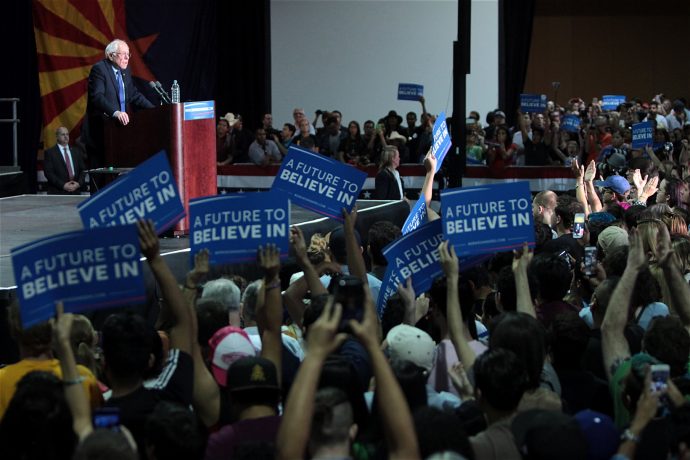What a significant part of the political class disparages as Bernie Sanders’ egomania may actually reflect something else, something that is morally quite far removed from garden variety egoism. Sanders’ evident grit and passion, and even his repetitive “one note” stump speech, may be rooted in an old and almost forgotten dream: a dream that is in many ways the antithesis of the 20th century American Dream of purely individual achievement.
This is the dream of a just commonwealth that animated what historians call the “long 19th century,” a time when the prerogatives and pretensions of the wealthy were aggressively and repeatedly challenged by self-respecting farmers, by small business owners threatened by the monopolists, and by the savagely exploited people who toiled for endless hours in mines and mills and railways. It is a millenarian dream whose tenor was well captured by the young Sidney Hillman in a letter written to his infant daughter in 1918: “One can hear the footsteps of the Deliverer…Labor will rule and the World will be free.”
This dream of deliverance, this longing for the overthrow of a predatory overclass, was deep and broad enough to unite labor radicals like Hillman and upper middle class reformers like Jane Addams. It was a dream heartily embraced by a significant cohort of “Social Gospel” leaders (e.g., Washington Gladden, Walter Rauschenbusch, and George D. Herron) who were appalled by what they regarded as the blasphemous identification of most other church leaders with the capitalist cause (e.g. Henry Ward Beecher, who blithely reassured his Brooklyn congregation that “God has intended the great to be great and the little to be little…”).
In its depth and breadth, the popular rejection of plutocracy between 1870 and 1919 (the year of the Palmer Raids and a sharp turn against radicalism) channeled widespread moral revulsion and crested on a surge of righteous indignation against what the protesters regarded as the criminality and arrogance of Gilded Age manipulators (Jay Gould: “I can hire one of of the working class to kill the other half.”). Resistance and protest rested the old republican and biblical idea of radical equality and on a furious rejection of the idea that wealth equals political entitlement. Open class conflict became a defining feature of American life throughout many decades when Americans still liked bragging to the rest of the world that theirs was a classless society.
To be clear, I am not suggesting that the young people drawn to Sanders rallies, or the embittered working class people voting for Sanders, are consciously trying to revive the old ways of resistance. I am not suggesting that most in the Sanders camp are aware of the Great Uprising of 1877 (a railway strike that rapidly morphed into a general strike) or the Great Upheaval of the 1880s (the bold and often violent campaign for an eight hour work day). I doubt that many even know who Sidney Hillman was, let alone Walter Rauschenbusch. They may think that Mother Jones is just a weird name for a magazine.
Whether the Sanders “revolution” of 2016 aligns perfectly with the chants democratic of a long-forgotten era is not the point. What matters is the shared spirit of defiance, the willingness to be rowdy and noisy in ways that irritate and provoke the stewards of politics as usual, and (most of all) the willingness to make big demands and ask big questions (again, in a way that annoys the hell out of mainstream “realists” like Paul Krugman).
Mark Twain, who in 1873 gave the Gilded Age its name, probably said it best: “History doesn’t repeat itself, but it does rhyme.”
The Sanders phenomenon is ostensibly secular, but its big aspirations and its frank recognition that the current economic order is rotten to the core have a lot in common with what historian Steve Fraser calls the “secular sacred” moral center of 19th-century resistance to capitalism’s amoral despoilers: Gould, Carnegie, Rockefeller, McCormick, Pullman, etc. Fraser, who subtly anatomizes the older resistance in the first half of his Age of Acquiescence (2015), pays appropriate attention to the Social Gospel preachers, but he also knows that theirs were relatively muted voices in relation to the clamoring of the majority of churchmen who gave their blessing to using militias and private armies to shoot down strikers “like mad dogs.”
What interests Fraser far more in relation to religion (and what interests me) is how early populist and working-class movements treated their cause as a righteous and holy one. For example, the full name of the once-mighty Knights of Labor was actually the Noble and Holy Order of the Knights of Labor. Meeting places for workers and union organizers were called labor “temples” for many decades—well into the 20th century. The early unionists were concerned with much more than wages, hours, and benefits–the sole concerns of the kind of business unionism that is most prevalent today. They demanded total social transformation, equating “wage slavery” with degradation and a horrible affront to democracy itself.
If we can easily see from our perspective how white racism and nativism tainted and fatally handicapped their insurgency, we should also remember how resentment and suspicion of “the other” were consciously and continuously stoked by the so-called Captains of Industry and their many handmaidens in press and pulpit.
Fraser is also helpful in illuminating how the earlier movement’s celebrity intellectuals and journalists–Henry George, Edward Bellamy, Henry Demarest Lloyd, even well-read labor firebrand Eugene V. Debs—invoked quasi-religious imagery and expressed what amounted to a second flowering of antebellum Christian Perfectionism (although Fraser does not use that term) in speeches and writings that, on their surface, remained resolutely secular.
And what of today’s uprising? It is obviously fueled by the energy of millennials (more of whom are now living back at home with Mom and/or Dad than with a spouse or partner, and not by choice, according to a new report).
But do these struggling and fired-up millennials have actual millenarian aspirations? Are they willing to go the distance for a different kind of society during this Second Gilded Age, a time when economic exploitation and political corruption look different but smell the same as in 1886? I have heard the argument that they are merely venting their personal confusion and trying to work through their personal crises via the political process; no doubt that is partly true, but I’m also wondering if there is more to it than that—if there is a rekindling of the small-d democratic flame.
I don’t know, and I don’t know whether anyone else really knows. But to me it is significant, even breathtaking, that as a consequence of the Sanders campaign AND as consequence of worsening job quality and rising debt, a majority of millennials now say that they prefer socialism to capitalism. In fact, thanks to Sanders, more than a third of all Americans now have a favorable view of socialism.
What may have begun as a quixotic quest on Sanders’ part has opened up a space on the left that no one knew existed in the era of what historian Fraser, in the second half of his Acquiescence book, calls “techno-determinism.” It is a space that is reminding serious organizers that winning structural change is ultimately about understanding power and using power. To be reminded that revolution is still possible is utterly thrilling; to be reminded that making a revolution amounts to hard, grueling, lifelong work is sobering, even terrifying.
And what of Sanders himself? Does he even understand the full magnitude of what he has unleashed? In dreams begins responsibility, as Yeats wrote in contemplation of his later age.
It’s impossible for me to even guess what Bernie might be thinking now. But he certainly knows that mass rebellion—a revolt begun by everyday people against revolting conditions—is very much in the American grain. He keeps a picture of Gene Debs in his office, and I’m pretty sure he knows who Sidney Hillman was. All I can say is that a Democratic Party that for 30 years has been culturally liberal but economically neoliberal (i.e., conservative)—and that is increasingly beholden to campaign cash from the FIRE sector—had better hold on to its hat.





